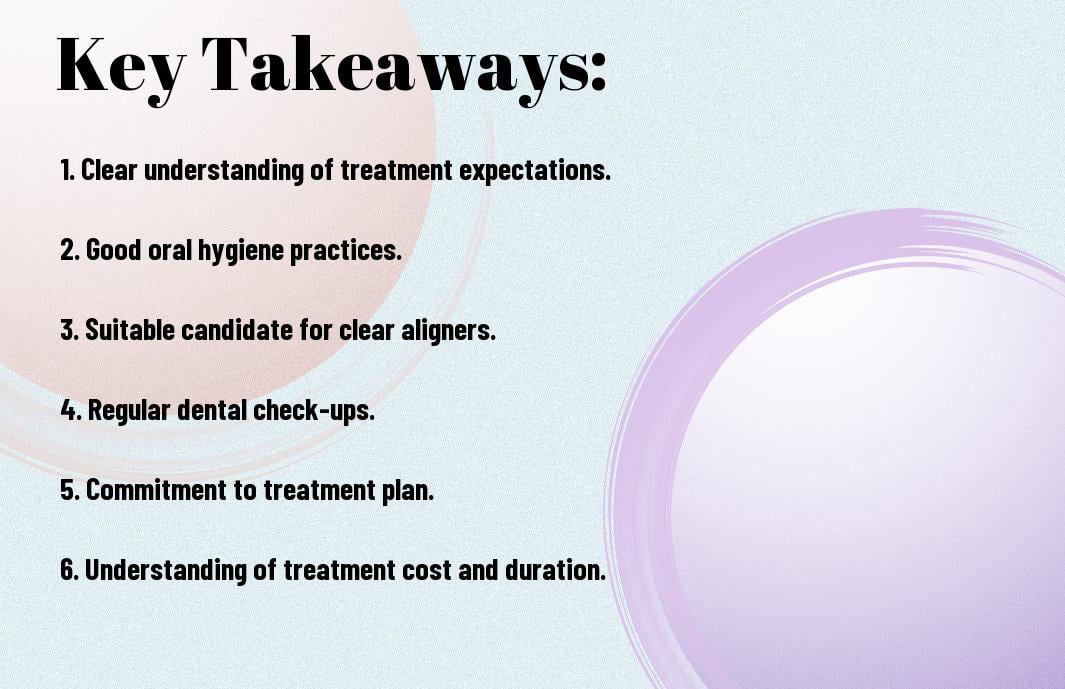Most people desire a straighter smile but may be hesitant about traditional metal braces. Invisible orthodontic treatments like clear aligners offer a discreet and convenient alternative. If you’re considering this option, it’s vital to understand the eligibility criteria to determine if you are a suitable candidate for invisible orthodontic treatment. Factors such as the severity of your misalignment, personal dental history, and commitment to treatment may play a role in determining your eligibility. This guide will help you assess whether invisible orthodontics are the right choice for your smile transformation journey.
Key Takeaways:
- Candidacy assessment: Meeting the eligibility criteria is crucial for invisible orthodontic treatment.
- Dental health: Good oral health is a key factor in determining eligibility for invisible aligners.
- Consultation: A consultation with an orthodontist is crucial to confirm eligibility and customize the treatment plan.
What is Invisible Orthodontic Treatment?
Definition and Overview
To begin with, invisible orthodontic treatment refers to the use of clear aligners to straighten your teeth discreetly. These aligners are custom-made removable trays that are virtually invisible when worn, making them a popular choice for individuals who wish to fix their dental alignment without the use of traditional metal braces. The process involves wearing a series of aligners that gradually shift your teeth into the desired position.
Benefits and Advantages
Overview: Invisible orthodontic treatment offers several benefits compared to traditional braces. These clear aligners are comfortable to wear and can be easily removed for eating and oral hygiene routines, unlike braces that are fixed onto your teeth. Additionally, the aligners are practically invisible, allowing you to straighten your teeth without drawing attention to your orthodontic treatment.
Plus, invisible orthodontic treatment typically requires fewer visits to the orthodontist for adjustments, as you can simply change to a new set of aligners every few weeks from the comfort of your home. This convenience makes it a convenient option for individuals with busy schedules who are looking to improve their smiles subtly.
General Eligibility Criteria
Age Requirements
Little age restriction is placed on individuals seeking invisible orthodontic treatment. As long as you have all your adult teeth, you can usually pursue these treatments. This means teenagers and adults alike can benefit from invisible orthodontics to improve their smiles.
Oral Health Status
On your journey to getting invisible orthodontic treatment, your oral health status plays a crucial role. With good oral health, you are more likely to be eligible for this type of treatment. Your orthodontist will assess your oral health to ensure that there are no underlying issues that could interfere with the treatment process.
With proper oral hygiene habits and routine dental check-ups, you can maintain your oral health throughout the treatment. This will help ensure the success of your invisible orthodontic treatment and prevent any complications along the way.
Dental Alignment Issues
Another important factor in determining your eligibility for invisible orthodontic treatment is the severity of your dental alignment issues. Minor to moderate alignment issues, such as crooked or crowded teeth, can often be addressed with invisible aligners. However, more severe cases may require alternative orthodontic treatments.
Alignment is necessary for the success of invisible orthodontic treatment. Your orthodontist will evaluate your dental alignment issues to determine if invisible aligners are the right option for you. They will create a customized treatment plan to gradually move your teeth into the desired position for a straighter smile.
Specific Orthodontic Conditions
Mild to Moderate Crowding
To begin with, all cases of mild to moderate crowding can be effectively treated with invisible orthodontic options. To address this common orthodontic issue, clear aligners can gradually shift your teeth into alignment, creating space and improving the overall appearance of your smile. These aligners are custom-made to fit your teeth and are virtually invisible, making them a discreet and convenient treatment option.
Spacing Issues
For cases where there are gaps or spaces between your teeth, invisible orthodontic treatment can also be a suitable option. Clear aligners can gently move your teeth closer together, closing gaps and creating a more symmetrical smile. Plus, the aligners are removable, allowing you to maintain good oral hygiene throughout the treatment process.
Furthermore, invisible orthodontic treatment can also address other spacing issues, such as unevenly spaced teeth or gaps that impact the alignment of your bite. By customizing the treatment plan to your specific needs, clear aligners can help you achieve a more harmonious and balanced smile.
Overbite and Underbite
Overbite and underbite are common orthodontic conditions that can impact the function and aesthetics of your smile. With invisible orthodontic treatment, overbites can be corrected by gradually shifting your upper teeth to overlap your lower teeth properly. This process helps improve the alignment of your bite and can also enhance the appearance of your smile.
Mild to moderate cases of underbite can also be effectively treated using invisible orthodontic options. By customizing the treatment plan to address your specific bite alignment, clear aligners can help reposition your lower teeth to align with your upper teeth, resulting in a more balanced and functional bite.
Additional Factors Affecting Eligibility
Factors affecting your eligibility for invisible orthodontic treatment go beyond just the alignment of your teeth. Your overall oral health plays a significant role in determining if you are a suitable candidate for this type of treatment. Issues such as gum recession, tooth decay, and previous orthodontic treatments can impact your eligibility for invisible aligners.
Gum Recession and Periodontal Disease
Factors such as gum recession and periodontal disease can affect your eligibility for invisible orthodontic treatment. If you have significant gum recession or are dealing with periodontal disease, invisible aligners may not be the best option for you. These conditions can impact the stability of your teeth and the overall success of aligner treatment.
This is why it is vital to address any gum recession or periodontal issues before considering invisible orthodontic treatment. Your orthodontist will evaluate your oral health and recommend the best course of action to ensure the success of your treatment plan.
Tooth Decay and Fillings
Decay and existing fillings can also impact your eligibility for invisible orthodontic treatment. If you have untreated tooth decay or extensive fillings, invisible aligners may not be the most suitable option for you. These factors can affect the fit of the aligners and the overall outcome of your treatment.
This is why it is crucial to address any decay or filling issues before beginning treatment with invisible aligners. Your orthodontist will assess the condition of your teeth and recommend any necessary dental work before proceeding with orthodontic treatment.
Previous Orthodontic Treatment
Periodontal considerations must be taken into account when determining your eligibility for invisible orthodontic treatment. If you have a history of gum disease or other periodontal issues, this may impact the success of your treatment with invisible aligners.
Understanding your dental history and any previous orthodontic treatments you have undergone is crucial in evaluating your eligibility for invisible orthodontic treatment. Your orthodontist will consider these factors when creating a customized treatment plan to ensure the best results for your smile.
Assessing Your Eligibility
Consultation with an Orthodontist
On your journey to getting invisible orthodontic treatment, the first step is to schedule a consultation with an orthodontist. During this appointment, the orthodontist will assess your teeth, jaw alignment, and overall oral health to determine if you are a suitable candidate for invisible braces. They will discuss your treatment options and create a personalized plan tailored to your needs.
Diagnostic Tools and Imaging
An important aspect of assessing your eligibility for invisible orthodontic treatment is utilizing diagnostic tools and imaging techniques. These tools provide the orthodontist with detailed information about your teeth and jaw structure, allowing them to accurately plan your treatment. X-rays, 3D scans, and photographs are commonly used to assess your dental health and create a customized treatment plan.
These diagnostic tools help the orthodontist identify any underlying issues that may affect your treatment, such as misalignments or abnormalities in the teeth or jaw. By using advanced imaging techniques, they can visualize the position of each tooth and create a step-by-step plan to gradually move them into the desired alignment.
Personalized Treatment Planning
Plus, invisible orthodontic treatment involves personalized treatment planning to ensure optimal results. Your orthodontist will take into account your unique dental structure, alignment issues, and treatment goals when creating your customized plan. They will outline the estimated duration of your treatment, the expected progress at each stage, and the final outcome you can anticipate.
Your orthodontist will discuss the treatment process with you in detail, explaining how the invisible braces will gradually shift your teeth into alignment. They will address any concerns you may have and provide you with a clear understanding of the steps involved in your treatment plan. Throughout the process, your orthodontist will monitor your progress and make any necessary adjustments to ensure the best outcome for your smile.
Exceptions and Special Cases
Severe Orthodontic Issues
An exception to invisible orthodontic treatment eligibility is when there are severe orthodontic issues that cannot be addressed effectively with clear aligners alone. In such cases, traditional orthodontic treatments like braces might be more suitable to achieve the desired results. If you have complex alignment or bite issues, your orthodontist may recommend a different treatment approach to ensure the best outcome for your smile.
Medical Conditions Affecting Treatment
For individuals with certain medical conditions that affect the alignment of their teeth, invisible orthodontic treatment may not be suitable. Medical conditions like severe gum disease or enamel hypoplasia can impact the success of clear aligner therapy. It is crucial to discuss any underlying medical conditions with your orthodontist to determine if invisible orthodontic treatment is the right choice for you.
It is crucial to be transparent about your medical history and any ongoing conditions to ensure your orthodontic treatment plan is customized to your specific needs. Your orthodontist will consider all factors, including medical conditions, to recommend the most appropriate treatment options for you.
Alternative Treatment Options
Medical advancements have led to a wide range of orthodontic treatment options beyond traditional braces and clear aligners. In some cases where invisible orthodontic treatment may not be suitable, alternative options such as lingual braces or surgical orthodontics could be considered. These alternative treatments offer solutions for complex orthodontic issues that cannot be effectively addressed with clear aligners.
Plus, advancements in orthodontic technology continue to expand the range of treatment options available to patients. Your orthodontist can discuss these alternatives with you and help determine the best course of action based on your individual needs and treatment goals.
Summing up
Following this discussion on eligibility criteria for invisible orthodontic treatment, it is crucial to keep in mind the various factors that orthodontists consider when determining if you are a suitable candidate for this type of treatment. Factors like the severity of your alignment issues, your commitment to wearing aligners as instructed, and your overall oral health play significant roles in deciding if invisible orthodontic treatment is the right choice for you. Consulting with an experienced orthodontist is the best way to assess your eligibility and create a personalized treatment plan tailored to your specific needs.
FAQ
Q: What are the eligibility criteria for invisible orthodontic treatment?
A: To be eligible for invisible orthodontic treatment, individuals should have mild to moderate teeth misalignment, good oral hygiene, and overall oral health. It is important to consult with an orthodontist to determine if you are a suitable candidate for this type of treatment.
Q: Can anyone get invisible orthodontic treatment?
A: Not everyone is a suitable candidate for invisible orthodontic treatment. Factors such as the severity of teeth misalignment, jaw issues, and oral health conditions may affect eligibility. A thorough evaluation by an orthodontist is necessary to determine if this treatment is right for you.
Q: What are the benefits of choosing invisible orthodontic treatment?
A: Invisible orthodontic treatment offers benefits such as discreetness, comfort, and convenience. The clear aligners are nearly invisible, making it a popular choice for individuals seeking a more subtle teeth straightening option. Additionally, the aligners are removable, allowing for easier maintenance of oral hygiene compared to traditional braces.







